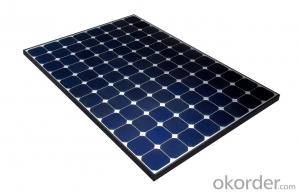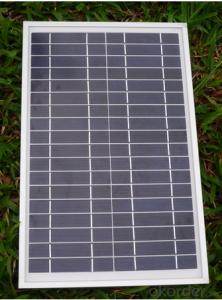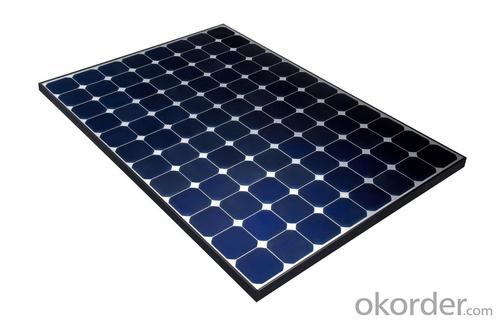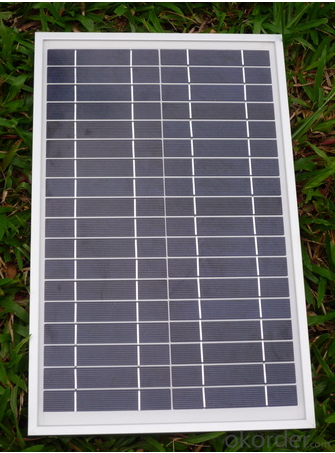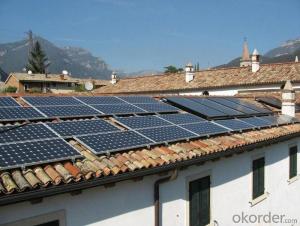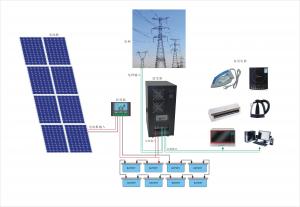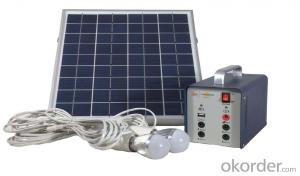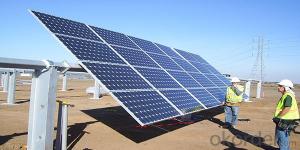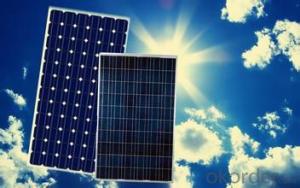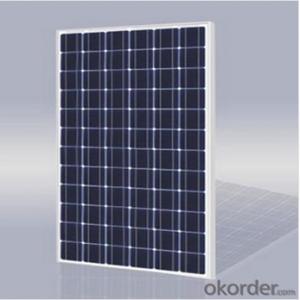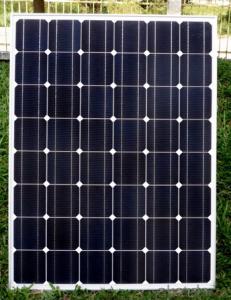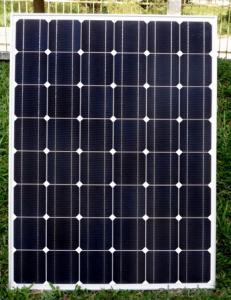110kw CNBM Monocrystalline Silicon Solar Energy Systems Panel for Home Use
- Loading Port:
- Tianjin
- Payment Terms:
- TT OR LC
- Min Order Qty:
- 10 watt
- Supply Capability:
- 1000 watt/month
OKorder Service Pledge
OKorder Financial Service
You Might Also Like
Specification
110KW CNBM Monocrystalline Silicon Panel for Home Using
Production description
On 13 April 2006, USA Today reported that there were "some 180,000 families living off-grid, a figure that has jumped 33% a year for a decade," and cited Richard Perez, publisher of Home Power Magazine,[6] as the source.[7] Assuming the same rate of growth, there would be a quarter million off-grid households in the United States by late 2007. Because many Third World citizens have never had the chance to go on the grid, current estimates are that 1.7 billion people live off-grid worldwide.[8] A wave of TV shows and articles came out after the publication of "Off the Grid, Inside the Movement for More Space, Less Government and True Independence in Modern America" by Nick Rosen in 2010.[9]Off-the-grid homes are autonomous; they do not rely on municipal water supply, sewer, natural gas, electrical power grid, or similar utility services. A true off-grid house is able to operate completely independently of all traditional public utility services. The idea has been recently popularized by certain celebrities including Ed Begley, Jr.[1] who stars in Living with Ed[2] television show on the Home & Garden Television (HGTV) network. Actress Daryl Hannahpromotes off-grid living and constructed her home in Colorado according to those principles, as does survival expert and Dual Survival co-star Cody Lundin,[3]who lives in a self-designed, passive solar earth house in the high-desert wilderness of Northern Arizona, collecting rainwater, composting waste, and paying nothing for utilities.[4][5]
The large magnitude of solar energy available makes it a highly appealing source of electricity. The United Nations Development Programme in its 2000 World Energy Assessment found that the annual potential of solar energy was 1,575–49,387 exajoules (EJ). This is several times larger than the total world energy consumption, which was 559.8 EJ in 2012.
Electrical power can be generated on-site with renewable energy sources such as solar (particularly with photovoltaics), wind, micro hydro, geothermal; with agenerator or Micro combined heat and power with adequate fuel reserves. Such a system is called a stand-alone power system. In addition, it is possible to simply eliminate electric power such as in Old Order Amish and Old Order Mennonite communities.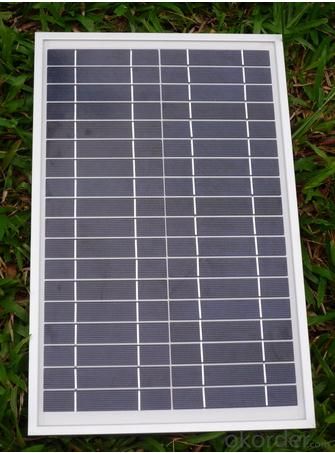
Feature
1.High conversion efficiencies resulting in superior power output performance.
2.Outstanding power output even in low light or high temperature conditions
3.Optimized design for ease of soldering and lamination
Physical characteristic
1. Rigorous quality control meets the highest international standards.
2. High-transmissivity low-iron tempered glass, strong aluminium frame.
3. Using UV-resistant silicon.
4. IS09001/14001/CE/TUV/UL
Packaging
26pcs in one carton 6pallets in 20foot container 14pallets in 40 foot container.
- Q: Can solar energy systems be used for commercial buildings?
- Yes, solar energy systems can be used for commercial buildings. Many businesses are increasingly adopting solar energy as a viable and sustainable source of power. Commercial buildings can install solar panels on rooftops or in open spaces to generate electricity, reduce energy costs, and lower carbon emissions. Additionally, government incentives and tax credits have made it financially attractive for businesses to invest in solar energy systems.
- Q: Can solar energy systems be used during a power outage?
- Yes, solar energy systems can be used during a power outage if they are equipped with battery storage. The batteries store excess solar energy generated during the day, which can then be used to power essential appliances and devices during an outage. However, if a solar energy system is not equipped with battery storage, it will not be able to provide electricity during a power outage as it relies on the grid for operation.
- Q: Are there any tax credits available for installing solar energy systems?
- Yes, there are tax credits available for installing solar energy systems. The federal government offers the Investment Tax Credit (ITC), which provides a credit of 26% of the total cost of the solar system installed. Some states also offer their own tax credits, incentives, or grants for solar installations. It is advisable to consult a tax professional or contact local authorities to determine the specific credits available in your area.
- Q: How do solar energy systems contribute to reducing the need for new power plant construction?
- Solar energy systems contribute to reducing the need for new power plant construction by providing a clean and renewable source of electricity. By harnessing the power of the sun, solar energy systems produce electricity without emitting harmful greenhouse gases or pollutants like traditional power plants. This reduces the overall demand for electricity from fossil fuel-based power plants, thereby reducing the need for new power plant construction. Additionally, solar energy systems can be installed on rooftops, unused land, or integrated into buildings, making them versatile and minimizing the need for large-scale power plant infrastructure.
- Q: Can a solar energy system be installed in areas with extreme weather conditions?
- Yes, a solar energy system can be installed in areas with extreme weather conditions. Solar energy systems are designed to withstand a wide range of weather conditions, including extreme cold, heat, wind, rain, and snow. In fact, solar panels are commonly used in various regions with extreme weather conditions, such as deserts, arctic regions, and coastal areas. To ensure the durability and efficiency of the system, solar panels are built with high-quality materials that can withstand harsh weather conditions. They are designed to be impact-resistant and are tested to withstand hail, strong winds, and heavy snow loads. Additionally, the frames and mounting systems used for solar panels are engineered to provide stability and protection against extreme weather events. In extreme cold weather conditions, solar energy systems can still function efficiently, although their performance may be slightly reduced due to lower temperatures. Solar panels are designed to absorb sunlight, which allows them to generate electricity even in low-light conditions. In snowy regions, solar panels are typically installed at an angle to facilitate snow shedding and prevent snow buildup that could reduce their efficiency. In areas with extreme heat, solar energy systems can still operate effectively, although the efficiency of the panels may be slightly reduced due to increased temperatures. However, modern solar panels are designed with heat dissipation features to minimize any performance losses caused by high temperatures. Overall, solar energy systems are highly adaptable and can be installed in areas with extreme weather conditions. They are designed to withstand a wide range of weather elements and continue to generate clean and renewable energy even in challenging environments.
- Q: Can solar energy systems be used for powering electric vehicle delivery services?
- Yes, solar energy systems can definitely be used for powering electric vehicle delivery services. Solar panels can be installed on the roofs of warehouses or delivery hubs to generate clean and renewable electricity. This solar energy can then be stored in batteries or directly used to charge the electric vehicles used for delivery services. By harnessing the power of the sun, electric delivery vehicles can be charged during the day and be ready to use for deliveries. This not only reduces the carbon footprint associated with delivery services but also helps to reduce operating costs by saving on fuel expenses. Furthermore, using solar energy for electric vehicle delivery services promotes sustainable practices and supports the transition to a greener and more sustainable future.
- Q: Can a solar energy system be installed in an area with high pollution levels?
- Yes, a solar energy system can be installed in an area with high pollution levels. While pollution can potentially reduce the efficiency of solar panels, it does not completely prevent their installation or operation. Solar panels are designed to withstand various environmental conditions, including air pollution. Although pollution may reduce the amount of sunlight reaching the panels, advancements in solar technology have made them more resilient and able to perform even in less than ideal conditions. Furthermore, the installation of solar energy systems in polluted areas can help mitigate the environmental impact of pollution by providing a clean and renewable source of energy.
- Q: Can solar energy systems be used in areas with heavy snowfall?
- Yes, solar energy systems can be used in areas with heavy snowfall. While snow can temporarily reduce the efficiency of solar panels, modern systems are designed to withstand and continue producing electricity in harsh weather conditions. Additionally, the angle at which the panels are installed can be optimized to allow snow to slide off easily. Regular maintenance, such as removing snow accumulation, can help maximize their performance in snowy regions.
- Q: Can solar energy systems be used in areas with high pollution levels?
- Yes, solar energy systems can be used in areas with high pollution levels. Solar panels generate electricity by converting sunlight into energy, and their performance does not depend on air quality. While pollution may reduce the amount of sunlight reaching the panels, they can still function and produce electricity. However, it's worth noting that regular cleaning of the panels may be necessary to maintain optimal efficiency in areas with high pollution levels.
- Q: How do solar energy systems affect the electrical wiring of a building?
- Solar energy systems can have an impact on the electrical wiring of a building, as they typically require the installation of new wiring to connect the solar panels to the building's electrical system. This involves adding a new circuit breaker and running wires from the panels to the building's main electrical panel. However, the overall effect on the existing electrical wiring is minimal, as the solar energy system operates independently and does not interfere with the normal functioning of the building's electrical system.
Send your message to us
110kw CNBM Monocrystalline Silicon Solar Energy Systems Panel for Home Use
- Loading Port:
- Tianjin
- Payment Terms:
- TT OR LC
- Min Order Qty:
- 10 watt
- Supply Capability:
- 1000 watt/month
OKorder Service Pledge
OKorder Financial Service
Similar products
Hot products
Hot Searches
Related keywords
